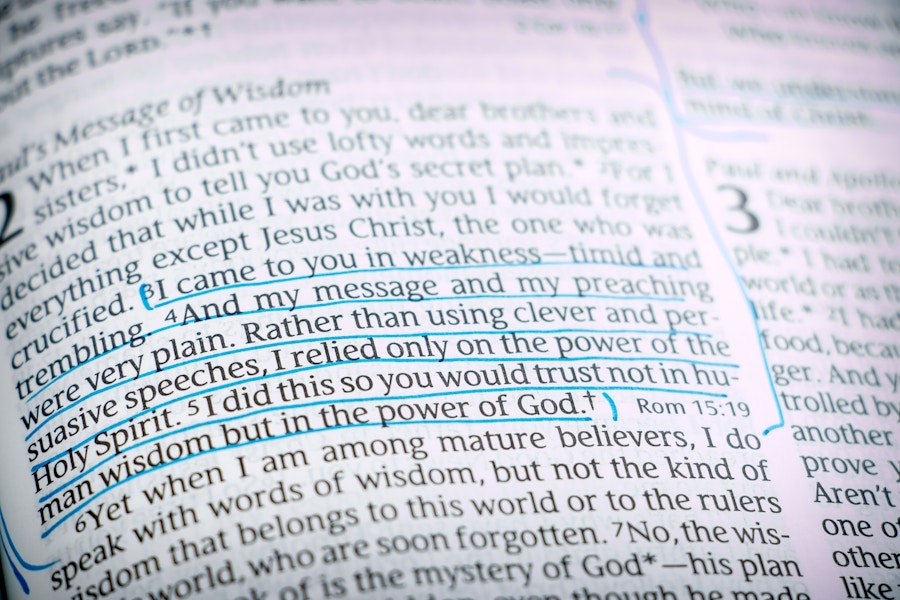 Excerpt from Streams of Living Water
Excerpt from Streams of Living Water
The Evangelical Tradition is comprised of three great themes: first, and foremost, the faithful proclamation of the gospel; second, the centrality of Scripture as a faithful repository of the gospel; and third, the confessional witness of the early Christian community as a faithful interpretation of the gospel.
A Faithful Proclamation
The evangel message is the good news of redemption and reconciliation, powerfully captured in the words of the Apostle Paul: “If anyone is in Christ, he is a new creation; the old has gone, the new has come! All this is from God, who reconciled us to himself through Christ and gave us the ministry of reconciliation.… We are therefore Christ’s ambassadors, as though God were making his appeal through us. We implore you on Christ’s behalf: Be reconciled to God” (2 Cor. 5:17 – 20, NIV).
This evangel, this euangelion, this wonderful good news is that we no longer have to stand outside, barred from nearness to God by our sin and rebellion. Knowing that we are a stiff-necked and hardhearted people, God has provided us a way into his heart. And that way is through him who says, “I am the way, and the truth, and the life” (John 14:6). Jesus Christ is the door that opens into God’s great grace and mercy.
The evangel message is rooted in the person of Jesus Christ, the Word of God living. In the Christ event — Jesus’ birth, life, death, and resurrection — the way has been opened for us to be reconciled to God.
Jesus himself announced this good news of the gospel in his cryptic call, “Repent, for the kingdom of heaven has come near” (Matt. 4:17). The word repent here means literally “to turn around in your mind.” In other words, we should reevaluate our whole way of living in light of this great fact: in the person of Jesus Christ the kingdom of heaven has been made accessible to human beings.1
What does this mean? It means that we can be reconciled to God. It means that we can be made new. It means that we can be born from above. It means that we can experience the forgiveness of sins through the atoning death of Jesus on the cross.2 It means that we can enter a loving, living, eternal relationship with God the Father, through Jesus Christ the Son, by the power of the Holy Spirit. Surely this is great, good news!
Listen to Jesus’ grand invitation of grace: “Come to me, all you that are weary and are carrying heavy burdens, and I will give you rest. Take my yoke upon you, and learn from me; for I am gentle and humble in heart, and you will find rest for your souls. For my yoke is easy, and my burden is light” (Matt 11:28 – 30).
So we are invited into a new life in Christ. And that new life is ours by faith alone. There are no things we do to get good enough to receive this life. It is all grace and all gift: “For by grace you have been saved through faith, and this is not your own doing; it is the gift of God not the result of works, so that no one may boast” (Eph. 2:8 – 9). In the words of P. T. Forsyth, “Christianity is not the sacrifice we make, but the sacrifice we trust; not the victory we win, but the victory we inherit. That is the evangelical principle.”3
Please understand, we are not here talking exclusively (or even primarily) about how we may get into heaven when we die. Getting into heaven is a matter of genuine consequence (and it does, in fact, come as part of the total package), but the evangel of the gospel is that abundant life in Christ begins now, and death becomes only a minor transition from this life to greater Life.
So the evangel, the good news of the gospel, is that we enter into life in Christ as his disciple right now. It is not that we believe now, enrolling as his disciple at some later point if we are so inclined (as if it were possible to believe without being his disciple). Believing in Jesus and discipleship to Jesus are part of the same action. We accept Jesus Christ, the living Word of God, as our life. He then promises to be yoked to us as we are yoked to him, and to teach us how to live our life as he would live it if he were in our place. He is alive and among us in all his offices: as our Savior to redeem us, as our Teacher to guide us, as our Lord to rule us, and as our Friend to come alongside us. In this way we grow ever more into Christlikeness, “for those whom [God] foreknew he also predestined to be conformed to the image of his Son” (Rom. 8:29a).
Even more, we are given the honor of sharing this good news of ongoing life in Christ with all peoples: “Go therefore and make disciples of all nations, baptizing them in the name of the Father and of the Son and of the Holy Spirit, and teaching them to obey everything that I have commanded you” (Matt. 28:19 – 20a).
Now, we do not do this without the working of this transforming life in ourselves. We cannot preach the good news and be the bad news. So, making the necessary cultural adjustments, we step into the life of the Gospels and do what they did and live as they lived. As we take the words of Christ into our hearts, and those around us — seeing the transforming power of God in us — say, “We need to get in on this.” What we are offering the world is life as it was meant to be.
Remember, we are calling people not merely to accept a set of beliefs about Jesus that will somehow trip the divine lever and get them into heaven when they die. Oh, no! We are calling people to turn to Jesus as their life. We are inviting people to believe in Jesus by becoming his disciples, and as his disciples (or apprentices) to enroll in his school of living. Thus people become trained in the Way, increasingly taking into themselves Jesus’ hopes, dreams, longings, habits, and abilities. This is how they learn “to obey everything that I have commanded you.” There simply is no other way.
A Faithful Repository
This evangel message has been faithfully preserved and presented to us in Scripture. The Bible is the Word of God written, just as Jesus is the Word of God living. Evangelical faith is biblical faith. The Gospels — Matthew, Mark, Luke, and John — stand at the heart of the biblical witness, for they faithfully give us the Christ event. The Epistles are the interpretative record of the Christ event, and we receive the Hebrew Scriptures as the written Word of God because Jesus did. And Paul’s confessional statement is ours as well: “All scripture is inspired by God and is useful for teaching, for reproof, for correction, and for training in righteousness, so that everyone who belongs to God may be proficient, equipped for every good work” (2 Tim. 3:16 – 17).
Many and varied are the apologetic witnesses to the inspiration and authority of Scripture, and beyond affirming their validity, we need not go into them here. But alongside them we can add what the old writers called the indicia , the inward testimony of Scripture, for it is the uniform witness of the Church that, as illuminated by the Spirit, Scripture authenticates itself.
The evangelical witness affirms the primacy of Scripture as the only infallible rule of faith and practice. This cannot be stressed enough. Scripture has primacy over other writings; primacy over church tradition; primacy over individual religious experience; primacy over the individual conscience; primacy over individual revelations, dreams, and visions; primacy over culture.4 As the Protestant reformers put it, Sola Scriptura, the Scripture alone. This important confession gives us a standard or a norm for discerning faith and practice. Theologians, in fact, call Scripture the “formal norm” (just as Jesus and his message are the “material norm”) for Christian faith and practice. This by no means solves all of our problems, for huge questions of interpretation (hermeneutics) remain, but it does give us a basis upon which to work on the various problems that confront us almost daily.
A Faithful Interpretation
The evangel message of new life in Christ spread rapidly to virtually every culture and people group in the known world of that day. Soon, however, competing views began to emerge, some claiming to replace or even surpass the good news of the gospel. Clarification was needed. In the New Testament Epistles, especially those attributed to Paul, we see the beginnings of this clarification and interpretation of the Christ event. We cannot, for example, read Paul’s great christological statement in Colossians 1:15 – 20 without the deepest admiration and thanksgiving to God for it:
He is the image of the invisible God, the firstborn of all creation; for in him all things in heaven and on earth were created, things visible and invisible, whether thrones or dominions or rulers or powers all things have been created through him and for him. He himself is before all things, and in him all things hold together. He is the head of the body, the church; he is the beginning, the firstborn from the dead, so that he might come to have first place in everything. For in him all the fullness of God was pleased to dwell, and through him God was pleased to reconcile to himself all things, whether on earth or in heaven, by making peace through the blood of his cross.
This clarifying and interpreting work continued on for some time — roughly five centuries. Several great “ecumenical councils” were held during those years to hammer out as clear an understanding of the Christ event as possible.5 A precursor to these councils, as you may know, is recorded in our Bible the momentous Jerusalem Council of Acts 15, convened to clarify the grounds of salvation for Gentile disciples. (We might wish that all of the subsequent gatherings had the same Spirit-driven unity.)
The debates at these ecumenical councils were highly significant, for opposing positions abounded: Gnosticism and Marcionism and Montanism and Arianism and Nestorianism and Pelagianism and more.6 Perhaps the three most important councils were Nicea in A.D. 325 (which confessed Christ as fully divine), Constantinople in A.D. 381 (which confessed Christ as fully human), and Chalcedon in A.D. 451 (which confessed the unity of Christ two natures, one person).
These were matters of no small consequence, and what the councils concluded in regard to them has defined and clarified the Christ event for the Church ever after. For example, the Christian community has for fifteen hundred years looked to the Council of Chalcedon as providing the foundation of the doctrine of salvation in the unique God-man, Jesus Christ.
Probably the most famous of the clarifying statements from these ecumenical councils is the Nicene Creed, which grew out of and was named after the Council of Nicea. In its words we can see how carefully and forthrightly it was correcting the Arian notion that Christ was a created being and the Nestorian idea that Christ was two distinct beings. This statement is so powerful and so foundational to Christian conviction that it is best quoted in full:
We believe in one God the Father All-sovereign, maker of heaven and earth, and of all things visible and invisible; And in one Lord Jesus Christ, the only-begotten Son of God, Begotten of the Father before all the ages, Light of Light, true God of true God, begotten not made, of one substance with the Father, through whom all things were made; who for us men and for our salvation came down from the heavens, and was made flesh of the Holy Spirit and the Virgin Mary, and became man, and was crucified for us under Pontius Pilate, and suffered and was buried, and rose again on the third day according to the Scriptures, and ascended into the heavens, and sitteth on the right hand of the Father, and cometh again with glory to judge living and dead, of whose kingdom there shall be no end: And in the Holy Spirit, the Lord and the Life-giver, that proceedeth from the Father, who with Father and Son is worshipped together and glorified together, who spake through the prophets: In one holy Catholic and Apostolic Church: We acknowledge one baptism unto remission of sins. We look for a resurrection of the dead, and the life of the age to come.6
These affirmations and creeds, which seek to interpret and clarify the Christ event, must never carry the same weight and authority as Scripture, for evangelical conviction always calls for the primacy of Scripture as the formal norm in matters of faith and practice; but they are confessional statements of immense importance. Authentic evangelical witness is rooted in doctrinal fidelity as well as the transforming experience of conversion. What we believe matters, and the Evangelical Tradition has always concerned itself with clarity in belief. (Did you notice how much of this clarifying work Augustine did throughout his ministry?)
Such doctrinal concerns as the deity and humanity of Christ, his resurrection from the dead, and the doctrine of the Trinity are of prime interest to evangelical witness. Why? Because they, and other doctrinal beliefs like them, hold us to a faithful interpretation of the Christ event. This in turn enables us to proclaim the good news of the gospel, the evangel, with fidelity and integrity.
Related Podcast
Excerpted from Streams of Living Water by Richard J. Foster, published by HarperOne. Copyright Richard J. Foster. Used with permission.
[1] The word we translate repent is metanoeo. “Meta,” in this context, means to turn around or to go in a different direction, while “noeo” or “nous” means the mind, the understanding, the intellect hence “turn around in your mind.” Jesus is telling us to reevaluate everything we have understood about life, for his presence and his message of the kingdom change absolutely everything.
[2] Some may wonder why I do not say more about the vicarious, substitutionary death of Christ on the cross for the forgiveness of sins. The answer is not that I feel these matters are unimportant, but that I do not want people to mistake a theory of the atonement for the experience of saving grace. Personally, I hold that Christ’s death on the cross satisfied the justice of God and opened the way for our reconciliation with God, dependent upon our repentance and acceptance of the free gift of salvation. But again, this is one theory of the atonement, and many people have no doubt experienced saving grace and abundant life with Christ as his disciple without believing every jot and tittle of this particular theory. Of course, if I were writing a theology of the cross, I would delve into the doctrine of the atonement in detail.
[3] As quoted in Donald G. Bloesch, Essentials of Evangelical Theology, vol. 1 (San Francisco: Harper & Row, 1978), p.7.
[4] This primacy list is taken from Donald G. Bloesch, who has an extended discussion of each item listed. See Essentials of Evangelical Theology, vol. 1, chap 4.
[5] For a listing and discussion of each of the seven ecumenical councils, see Appendix A in Streams of Living Water.
[6] Documents of the Christian Church, 2nd ed., sel. and ed. Henry Bettenson (London: Oxford University Press, 1963), p. 26. The Nicene Creed went through several stages of development, from the gathering at Nicea ( A.D. 325) to Constantinople ( A.D. 381) to Chalcedon ( A.D. 451), where the creed took the form that is quoted in the text. If you compare this statement to the creed as we find it today, you will note some further development, although the substance is the same.
There are four “ecumenical” creeds:
1. The Apostles’ Creed, attributed to the original apostles but most likely adapted from an ancient Roman baptismal creed of the second century. The present form of the creed appeared around the sixth century.
2. The Nicene Creed, given in the text.
3. The Chalcedonian Creed, formulated in A.D. 451 to clarify the two natures of Christ — the relationship between his humanity and his divinity.
4. The Athanasian Creed, wrongly attributed by tradition to Athanasius. Though the real author and origin are unknown, this creed was probably written between the fifth and seventh centuries. The doctrines of the Trinity and the incarnation are developed in it.
Still other faith statements have been developed through the centuries, such as the Augsburg Confession (Lutheran), the Westminster Confession of Faith (Reformed), and the Richmond Declaration of Faith (Quaker). These should be thought of as ancillary teachings reinforcing particular denominational distinctives rather than as essential to evangelical faith and witness.
Text First Published October 1998


